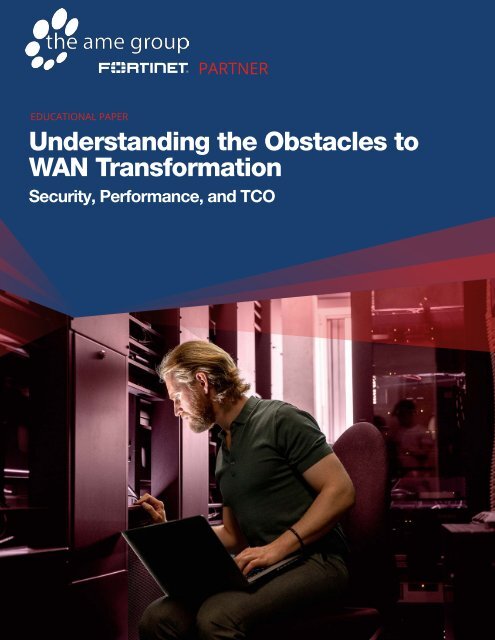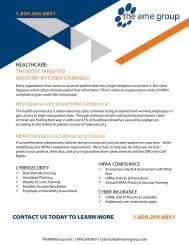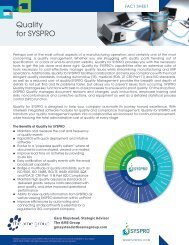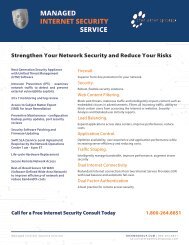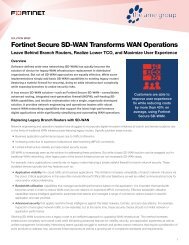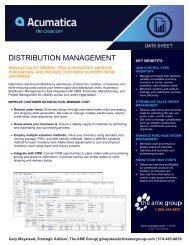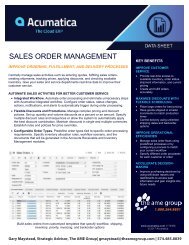Understanding the Obstacles to WAN Transformation
Network engineering and operations leaders are looking to replace their traditional wide-area network (WAN) architectures with software-defined wide-area networks (SD-WAN) in order to support the ever-increasing traffic demands (and associated connectivity costs) that come with digital innovation (DI). These DI-driven initiatives improve staff productivity and create new business opportunities. Yet, they also impact networking performance and ratchet up security concerns. SD-WAN adoption is accelerating and many organizations have embarked on SD-WAN implementations. But many SD-WAN solutions present serious challenges—from inadequate security to high total cost of ownership (TCO). Understanding these issues is key to navigating the increasingly complex market for WAN edge technologies. The AME Group is a Fortinet Advanced Partner serving Indiana, Southern Michigan, Ohio, Kentucky, Tennessee, Southern Louisiana and South-Eastern Texas.
Network engineering and operations leaders are looking to replace their traditional
wide-area network (WAN) architectures with software-defined wide-area networks
(SD-WAN) in order to support the ever-increasing traffic demands (and associated
connectivity costs) that come with digital innovation (DI). These DI-driven initiatives
improve staff productivity and create new business opportunities. Yet, they also
impact networking performance and ratchet up security concerns.
SD-WAN adoption is accelerating and many organizations have embarked on SD-WAN
implementations. But many SD-WAN solutions present serious challenges—from
inadequate security to high total cost of ownership (TCO). Understanding these issues is
key to navigating the increasingly complex market for WAN edge technologies.
The AME Group is a Fortinet Advanced Partner serving Indiana, Southern Michigan, Ohio, Kentucky, Tennessee, Southern Louisiana and South-Eastern Texas.
You also want an ePaper? Increase the reach of your titles
YUMPU automatically turns print PDFs into web optimized ePapers that Google loves.
PARTNER<br />
EDUCATIONAL PAPER<br />
<strong>Understanding</strong> <strong>the</strong> <strong>Obstacles</strong> <strong>to</strong><br />
<strong>WAN</strong> <strong>Transformation</strong><br />
Security, Performance, and TCO
Executive Summary<br />
Network engineering and operations leaders are looking <strong>to</strong> replace <strong>the</strong>ir traditional<br />
wide-area network (<strong>WAN</strong>) architectures with software-defined wide-area networks<br />
(SD-<strong>WAN</strong>) in order <strong>to</strong> support <strong>the</strong> ever-increasing traffic demands (and associated<br />
connectivity costs) that come with digital innovation (DI). These DI-driven initiatives<br />
improve staff productivity and create new business opportunities. Yet, <strong>the</strong>y also<br />
impact networking performance and ratchet up security concerns.<br />
SD-<strong>WAN</strong> adoption is accelerating and many organizations have embarked on SD-<strong>WAN</strong><br />
implementations. But many SD-<strong>WAN</strong> solutions present serious challenges—from<br />
inadequate security <strong>to</strong> high <strong>to</strong>tal cost of ownership (TCO). <strong>Understanding</strong> <strong>the</strong>se issues is<br />
key <strong>to</strong> navigating <strong>the</strong> increasingly complex market for <strong>WAN</strong> edge technologies.<br />
IDC projects that <strong>the</strong> market<br />
for SD-<strong>WAN</strong> will experience a<br />
compound annual growth rate<br />
(CAGR) of more than 40% through<br />
2022. 1<br />
How DI Is Impacting Corporate Networks<br />
Distributed organizations are embracing a wide range of DI technologies. This includes<br />
adoption of Software-as-a-Service (SaaS) applications, cloud on-ramping connectivity,<br />
Voice over IP (VoIP) and video communications <strong>to</strong>ols, use of DevOps <strong>to</strong> speed time<br />
deployment for new web applications, and Internet-of-Things (IoT) devices for data<br />
collection and telemetry.<br />
However, <strong>the</strong>se DI initiatives present new challenges for network engineering and operations<br />
leaders who must sustain both performance and security from <strong>the</strong> data-center campus<br />
<strong>to</strong> branch offices on <strong>the</strong> network edge. Outdated traditional <strong>WAN</strong>s at remote sites are not<br />
designed <strong>to</strong> support <strong>the</strong> volume and velocity of traffic that is being pushed <strong>to</strong> branches<br />
and distributed offices. Specifically, <strong>the</strong>se <strong>WAN</strong> solutions employ a multipro<strong>to</strong>col label<br />
switching (MPLS)-based network that backhauls all traffic through <strong>the</strong> corporate data<br />
center for filtering and security checks. This hub-and-spoke architecture can lead <strong>to</strong><br />
bottlenecks at <strong>the</strong> network edge, which results in sluggish performance for end-users—<br />
especially under <strong>the</strong> ever-increasing bandwidth demands that come with DI adoption.<br />
“The emergence of SD-<strong>WAN</strong><br />
technology has been one of <strong>the</strong><br />
fastest industry transformations<br />
we have seen in years.<br />
Organizations of all sizes are<br />
modernizing <strong>the</strong>ir wide-area<br />
networks <strong>to</strong> provide improved<br />
user experience for a range of<br />
cloud-enabled applications.” 2<br />
– Rohit Mehra<br />
VP, Network Infrastructure<br />
IDC<br />
But that is not <strong>the</strong> only problem with <strong>the</strong> traditional <strong>WAN</strong> solutions. MPLS connections<br />
are also expensive, and <strong>the</strong> costs can quickly compile as branch traffic volumes continue<br />
<strong>to</strong> climb with no end in sight.<br />
Encountering <strong>the</strong> Challenges of <strong>the</strong> Traditional <strong>WAN</strong><br />
In response, many organizations are embracing SD-<strong>WAN</strong> solutions on <strong>the</strong> basis that <strong>the</strong>y deliver better network performance. Yet, <strong>the</strong>re<br />
are a number of different SD-<strong>WAN</strong> solutions on <strong>the</strong> market with varying capabilities, and it can quickly become a challenge determining<br />
which one meets core business requirements. Before a network engineering and operations leader can evaluate available options, <strong>the</strong>y<br />
need <strong>to</strong> consider <strong>the</strong> reasons this is <strong>the</strong> case with many SD-<strong>WAN</strong>s.<br />
Inadequate Security: Lack of Comprehensive Threat Protection<br />
Although throughput suffers when a <strong>WAN</strong> routes all traffic through <strong>the</strong> data center, MPLS-based <strong>WAN</strong>s are generally perceived as<br />
adequately secure. In contrast, for many SD-<strong>WAN</strong> solutions, advanced security is not built in or, if included, is insufficient. Specifically,<br />
<strong>the</strong> security capabilities in most SD-<strong>WAN</strong> solutions do not address <strong>the</strong> entirety of Layer 3 through Layer 7 advanced security, lacking<br />
2
<strong>Understanding</strong> <strong>the</strong> <strong>Obstacles</strong> <strong>to</strong> <strong>WAN</strong> <strong>Transformation</strong><br />
built-in intrusion prevention system (IPS) technology, web filtering, secure sockets layer<br />
(SSL)/transport layer security (TLS) inspection, and o<strong>the</strong>r protection types.<br />
To solve <strong>the</strong>se security requirements in branch and remote office networks, network<br />
engineering and operations leaders must pair dedicated security appliances alongside<br />
<strong>the</strong>ir SD-<strong>WAN</strong>. At bare minimum, this involves <strong>the</strong> addition of a firewall in each location—<br />
though sometimes more (e.g., secure sockets layer [SSL]/transport layer security [TLS]<br />
inspection is not available in every firewall on <strong>the</strong> market). But this creates complexity,<br />
which increases TCO—from capital expenditures (CapEx) for <strong>the</strong> additional appliance <strong>to</strong><br />
staff time (operational expenditures [OpEx]) spent managing <strong>the</strong> additional firewall and<br />
o<strong>the</strong>r appliances.<br />
Even among SD-<strong>WAN</strong> solutions that do include more advanced technologies, gaps<br />
still exist. For example, not every SD-<strong>WAN</strong> solution has security options that have been<br />
thoroughly vetted by third-party experts such as NSS Labs. This objective comparison<br />
and analysis of SD-<strong>WAN</strong> solutions enables network engineering and operations leaders <strong>to</strong><br />
determine which SD-<strong>WAN</strong> solutions meet real-world business requirements best.<br />
“72% of <strong>the</strong> respondents [based<br />
on a Gartner survey] found that<br />
security was <strong>the</strong>ir <strong>to</strong>pmost concern<br />
when it comes <strong>to</strong> <strong>the</strong>ir <strong>WAN</strong>.” 3<br />
Performance: A Trade-off With Security<br />
The direct connectivity and load balancing of SD-<strong>WAN</strong> solutions improve performance<br />
over traditional <strong>WAN</strong>. But, just as is <strong>the</strong> case with security, this is ano<strong>the</strong>r area where all<br />
SD-<strong>WAN</strong> solutions are not created equal. In particular, not every SD-<strong>WAN</strong> solution is able<br />
<strong>to</strong> identify and classify application traffic and apply routing policies at a very granular level.<br />
The result is that certain applications cannot be prioritized over o<strong>the</strong>rs. With this one-sizefits-all<br />
application traffic model, critical applications, VoIP calls, and video can slow. This<br />
impedes end-user productivity.<br />
Fur<strong>the</strong>rmore, among <strong>the</strong> subset of SD-<strong>WAN</strong> solutions with built-in security, some of<br />
<strong>the</strong> security settings have <strong>the</strong> potential <strong>to</strong> degrade network performance. For example,<br />
turning on deep inspection of encrypted SSL/TLS can have a huge impact on throughput<br />
performance. But for those organizations electing <strong>to</strong> leave it turned off, <strong>the</strong>y put<br />
<strong>the</strong>mselves at heightened risk with 72% of network traffic being encrypted and 60% of<br />
attacks using encryption <strong>to</strong> hide malware with SSL and TLS encryption. 4 In addition, if <strong>the</strong><br />
solution cannot perform encrypted packet inspection, this obstructs correct traffic routing<br />
which degrades <strong>the</strong> quality of experience (QoE) for network users.<br />
Many companies that transition <strong>to</strong><br />
SD-<strong>WAN</strong> reap substantial savings<br />
on bandwidth connectivity—<br />
upwards of 40% in some cases. 5<br />
72% of network traffic is<br />
encrypted, with 60% of attacks<br />
using encryption <strong>to</strong>day.<br />
Cost and Resources: TCO Remains High<br />
The increasing volume and velocity of network traffic from VoIP, video, and SaaS-based<br />
applications are alarming, which dramatically increases network bandwidth costs for<br />
many organizations. Considering that MPLS costs are growing by as much as fourfold or<br />
fivefold, <strong>the</strong> cost savings of SD-<strong>WAN</strong> that uses <strong>the</strong> public internet is significant.<br />
Still, network engineering and operations leaders who deploy SD-<strong>WAN</strong> solutions are<br />
often surprised <strong>to</strong> find a much higher TCO than expected. Specifically, adding multiple<br />
appliances for different capabilities increases CapEx as well as <strong>the</strong> amount of time staff<br />
need <strong>to</strong> spend managing <strong>the</strong>m (OpEx). Network staff must manually moni<strong>to</strong>r and compile<br />
log information for threat management. This is time-consuming and highly inefficient.<br />
Fur<strong>the</strong>r, needing <strong>to</strong> deploy multiple point products for each remote office and<br />
branch location—everything from routers, <strong>to</strong> firewalls, <strong>to</strong> security web gateways, <strong>to</strong><br />
<strong>WAN</strong> optimization—incurs substantial staff time <strong>to</strong> manage. Each of <strong>the</strong>se has its<br />
own pro<strong>to</strong>cols and user interfaces. To achieve visibility and centralized control and<br />
demonstrate compliance with various industry and governmental regulations and<br />
security standards, network engineering and operations staff must expend manual time<br />
TCO for SD-<strong>WAN</strong> solutions ranges<br />
from $5 <strong>to</strong> $496 per megabit per<br />
second (Mbps). Organizations<br />
should carefully evaluate <strong>the</strong><br />
short- and long-term TCO of<br />
<strong>the</strong> SD-<strong>WAN</strong> solution <strong>the</strong>y are<br />
evaluating <strong>to</strong> determine which one<br />
offers <strong>the</strong> most capabilities at <strong>the</strong><br />
lowest TCO. 6<br />
3
<strong>Understanding</strong> <strong>the</strong> <strong>Obstacles</strong> <strong>to</strong> <strong>WAN</strong> <strong>Transformation</strong><br />
aggregating and reconciling data from each technology-specific silo. In <strong>the</strong> face of a skills shortage, this time expenditure can become<br />
quite costly, as network engineering and operations teams struggle <strong>to</strong> scale <strong>to</strong> meet <strong>the</strong>se requirements.<br />
Inefficiencies mount in distributed networks where management of networking and security solutions requires staff <strong>to</strong> travel <strong>to</strong> remote<br />
locations. Specifically, when SD-<strong>WAN</strong> solutions do not offer ei<strong>the</strong>r a virtual alternative or zero-<strong>to</strong>uch deployment capabilities, significant<br />
time expenditure for initial deployment and ongoing maintenance can add up quickly.<br />
Conclusion: What <strong>to</strong> Look for in SD-<strong>WAN</strong><br />
When evaluating <strong>the</strong> many available SD-<strong>WAN</strong> solutions, network engineering and operations leaders should ask <strong>the</strong> following questions<br />
about each of <strong>the</strong> solutions on <strong>the</strong>ir shortlist:<br />
•nWhat is included in <strong>the</strong> SD-<strong>WAN</strong> solution? How many separate products are needed <strong>to</strong> obtain effective routing, SD-<strong>WAN</strong> networking,<br />
and security capabilities?<br />
•nWhat real-world results have been documented in independent third-party tests such as those conducted by NSS Labs?<br />
•nHow has <strong>the</strong> solution been assessed in third-party analyst reports such as Gartner’s Magic Quadrants?<br />
•nAssuming <strong>the</strong> solution has built-in security, does it include advanced capabilities—Layer 3 through Layer 7 security controls: 1) IPS, 2)<br />
web filtering, and 3) deep inspection of SSL/TLS encrypted traffic?<br />
•nAssuming <strong>the</strong> solution has SSL/TLS inspection capability, what performance impact occurs when it is turned on?<br />
•nIs <strong>the</strong> solution application-aware and does it employ au<strong>to</strong>mated path intelligence for optimized routing and prioritization of businesscritical<br />
SaaS applications, VoIP calls, and video? Does <strong>the</strong> solution integrate with security elements across <strong>the</strong> enterprise and across<br />
different security areas (e.g., mail, cloud, endpoints, among o<strong>the</strong>rs) for integrated and au<strong>to</strong>mated threat-intelligence sharing?<br />
Contact Us Today for a Free<br />
SD-<strong>WAN</strong> Consult.<br />
1<br />
“SD-<strong>WAN</strong> Infrastructure Market Poised <strong>to</strong> Reach $4.5 Billion in 2022,” IDC, August 7, 2018.<br />
2<br />
Ibid.<br />
3<br />
Naresh Singh, “Survey Analysis: Address Security and Digital Concerns <strong>to</strong> Maintain Rapid SD-<strong>WAN</strong> Growth,” Gartner, November 12, 2018.<br />
4<br />
John Maddison, “More Encrypted Traffic Than Ever,” Fortinet Blog, December 10, 2018; Omar Yaacoubi, “The hidden threat in GDPR’s encryption push,”<br />
PrivSec Report, January 8, 2019.<br />
5<br />
Paul Ruelas, “Catching <strong>the</strong> SD-<strong>WAN</strong> wave: <strong>the</strong> cost savings hype and MPLS misconceptions need more explanation,” Network World, April 18, 2018.<br />
6<br />
Thomas Skybakmoen, “SD-<strong>WAN</strong> Comparative Report,” NSS Labs, August 8, 2018.<br />
www.<strong>the</strong>amegroup.com/fortinet<br />
Copyright © 2019 Fortinet, Inc. All rights reserved. Fortinet ® , FortiGate ® , FortiCare ® and FortiGuard ® , and certain o<strong>the</strong>r marks are registered trademarks of Fortinet, Inc., and o<strong>the</strong>r Fortinet names herein may also be registered and/or common law<br />
trademarks of Fortinet. All o<strong>the</strong>r product or company names may be trademarks of <strong>the</strong>ir respective owners. Performance and o<strong>the</strong>r metrics contained herein were attained in internal lab tests under ideal conditions, and actual performance and o<strong>the</strong>r<br />
results may vary. Network variables, different network environments and o<strong>the</strong>r conditions may affect performance results. Nothing herein represents any binding commitment by Fortinet, and Fortinet disclaims all warranties, whe<strong>the</strong>r express or implied,<br />
except <strong>to</strong> <strong>the</strong> extent Fortinet enters a binding written contract, signed by Fortinet’s General Counsel, with a purchaser that expressly warrants that <strong>the</strong> identified product will perform according <strong>to</strong> certain expressly-identified performance metrics and, in<br />
such event, only <strong>the</strong> specific performance metrics expressly identified in such binding written contract shall be binding on Fortinet. For absolute clarity, any such warranty will be limited <strong>to</strong> performance in <strong>the</strong> same ideal conditions as in Fortinet’s internal<br />
lab tests. Fortinet disclaims in full any covenants, representations, and guarantees pursuant here<strong>to</strong>, whe<strong>the</strong>r express or implied. Fortinet reserves <strong>the</strong> right <strong>to</strong> change, modify, transfer, or o<strong>the</strong>rwise revise this publication without notice, and <strong>the</strong> most<br />
current version of <strong>the</strong> publication shall be applicable. Fortinet disclaims in full any covenants, representations, and guarantees pursuant here<strong>to</strong>, whe<strong>the</strong>r express or implied. Fortinet reserves <strong>the</strong> right <strong>to</strong> change, modify, transfer, or o<strong>the</strong>rwise revise this<br />
publication without notice, and <strong>the</strong> most current version of <strong>the</strong> publication shall be applicable.<br />
Oc<strong>to</strong>ber 2, 2019 9:59 AM<br />
376872-0-0-EN<br />
D:\Fortinet\White Paper\<strong>Understanding</strong> <strong>the</strong> obstacles\wp-understanding-<strong>the</strong>-obstacles-<strong>to</strong>-wan-transformation-v1.1


